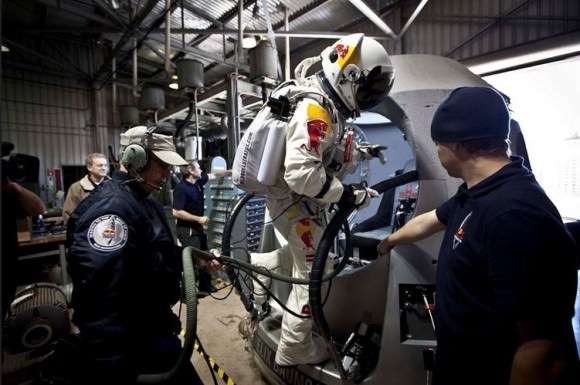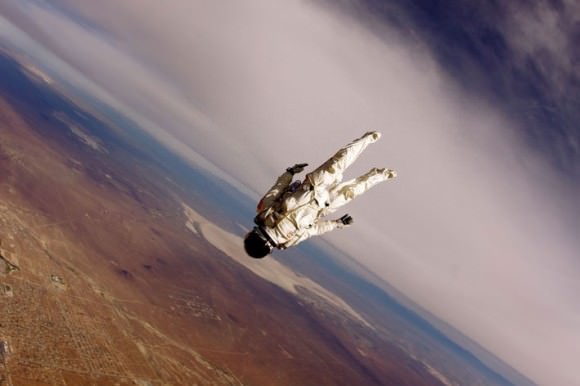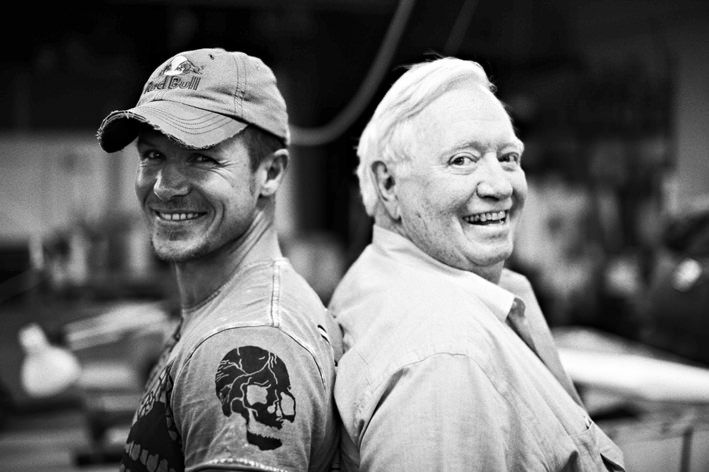In 2010, we reported on Felix Baumgartner and his upcoming attempt to break the sound barrier with his body, in a freefall from the edge of space. Part science experiment, part publicity stunt, part life-long ambition, the Red Bull Stratos mission will have Baumgartner traveling inside a capsule with a stratospheric balloon to 36,500 meters (120,000 feet), where he will step out and attempt a record-setting highest freefall jump ever. The mission was delayed by two years by a lawsuit, but Baumgartner’s jump is now back on, and will be attempted later this year, perhaps late summer or early fall 2012.
If Baumgartner is successful, the mission will break four world records: the altitude record for freefall, the distance record for longest freefall, the speed record for fastest freefall by breaking the speed of sound with the human body, and the altitude record for the highest manned balloon flight.
“This is the biggest goal I can dream of,” Baumgartner said. “If we can prove that you can break the speed of sound and stay alive I think that is a benefit for future space exploration.”
Above is a video of some of the preparations to test Baumgarter’s pressure suit and his body’s reaction to what he will endure during the freefall. The pressurized “space” suit and helmet supplies 20 minutes of oxygen includes especially designed equipment developed to capture data throughout the mission for the medical and scientific advancement of human flight.
The speed of sound — historically called the ‘sound barrier’ – has been broken by rockets, various jet-powered aircraft and rocket-boosted land vehicles. No one has broken it yet with just their body.
[/caption]
Back in 1960, a US Air Force captain named Joe Kittinger made aerospace history by making a jump from 31,000 meters (102,800 feet) in what was called project Excelsior. His jump contributed valuable data that provided ground work for spacesuit technology and knowledge about human physiology for the US space program. There have been several attempts to surpass Kittinger’s record, but none have succeeded, and people have given their lives for the quest.
Kittinger has been working with Baumgartner to help him prepare for the jump.
The Red Bull Stratos mission is named after the energy drink company that is sponsoring the jump by the renowned Austrian skydiver. Red Bull Stratos team members say the mission will explore the limits of the human body in one of the most hostile environments known to humankind, in the attempt to deliver valuable lessons in human endurance and high-altitude technology.
The lawsuit that halted the jump was made by Daniel Hogan, who claimed he pitched the idea of breaking the 50-year old freefall record to Red Bull in 2004, and that Red Bull said they weren’t interested, but later, the company went forward with the idea. Hogan filed a multi-million dollar lawsuit against the energy drink company, but the two parties settled out of court.
The delay may have been a good thing, however. Baumgartner revealed that in December 2010 during first pressure tests of the suit, he had a panic attack, an event which he called “the worst moment of his life.”

“When it came to the crucial pressure test at -60°C, under real conditions with pressure and altitude simulated, and surrounded by cameras, air force personnel and scientists, I realized I just couldn’t do it,” Baumgarter said in an article in the Red Bulletin.
Baumgartner said he thought the suit should feel like ‘second skin’ but instead he felt like his movements and perceptions were restricted. “As soon as the visor closes there’s this nightmarish silence and loneliness – the suit signifies imprisonment. We hadn’t originally conceived of a test that confined me in the suit for five hours – that’s how long the entire mission should take – with the visor closed. After all my past exploits, all the extreme things I’ve done in my career, no one would have ever guessed that simply wearing a space suit would threaten the mission, me included. In the end, the symptoms developed into panic attacks.”

But Baumgarter has been able to overcome the panic attacks and now is moving forward with the preparations for the jump. The jump will be recorded for a documentary with 15 cameras onboard the capsule and three cameras on Baumgarter’s body. The documentary will be produced by the BBC together with the National Geographic channel, with a feature-length film airing on the two channels following the jump.
The mission will take place in Roswell New Mexico because of the favorable conditions. The area is sparsely populated, plus it has some of the world’s best facilities for balloon launches such as this, and the weather allows several good windows for a successful launch.
For more information, see the Red Bull Stratos website, and the Red Bulletin.
Take a look at the infographic about the jump.


His blood wouldn’t boil in a vacuum would it? If it is inside his body, isn’t it safe? I thought that the blood boiling thing was a myth. If there was a puddle of blood in a vacuum, it would boil, but not if it is safely in his body.
The boiling blood is not a myth, and it happens to divers, too, if they resurface too quickly. The Dec. 1960 issue of the Nat’l. Geographic mag has a report written by Capt. Kittinger himself, in which he describes his “long, lonely leap”. The caption of a photo where he’s being made ready for the jump says: “Lest blood bubble like champagne, I put on a partial pressure suit for the near-vacuum where I am going.”
Not only the bodily fluids, but also the gases, can cause problems. On the next page it says: “As launch-day-minus-one progresses, I come under close scrutiny of our two project physicians. For a week I have been on a high-protein, low-residue diet, and I avoid gas-producing foods. Gas expands with increasing altitude, so the air trapped in my stomach or intestines could cause pain so severe that I could be forced to jump prematurely. The diet is mainly meat and potatoes.”
Another photo caption says: “To prevent the bends, I begin to breathe oxygen two hours before launch to decrease my body nitrogen.” A section of the report, titled “Oxygen Guards Against Bends”, gives additional explanations: “At 3 o’clock I enter the trailer that we use as a dressing room. Here I start breathing oxygen, and I will not take a breath of natural air until I reach lower altitudes on my descent, some four hours later. This gets most of the nitrogen out of my body. With increasing altitude, nitrogen forms bubbles that expand, cause severe pain, and can be fatal –an ailment known as the bends, which also threaten divers.”
Check out this post from Phil Plait. He says your blood will not boil because it is in a closed system. The bends is something different. The gas that is disolved in your blood is escaping, like in a soda can when you open it.
http://blogs.discovermagazine.com/badastronomy/2012/01/31/qba-what-happens-if-you-are-exposed-to-the-vacuum-of-space/
It’s a semantic problem: “boiling” is being used metaphorically. In both cases it’s a “bubbling”. Something can go quickly from the liquid to the gaseous phase either because of a temperature or because of a pressure change, but the change is in opposite directions: when temperature increases or when pressure decreases. In both cases the dissolved gas escapes or tries to do so. Since it can’t go anywhere in a confined space like the circulatory system it will cause great internal damage.
I have to disagree and I do not think it is just a question of semantics. Boiling and gases escaping from a solvent are very different processes. In the case of boiling, it is the solvent or liquid that is becoming gaseous. In the other case, the gas is being released from the solvent. If you get the”bends”, your blood is not bubbling, it is the gases that are disolved in the blood that are escaping. The wanter and blood remain. If your blood was boiling, the water would be turning into gas and you would likely explode from the pressure. Because the temperatures in space are so cold, it is unlikely that your body, exposed to the vacuum of space, would explode because there wouldn’t be enough pressure from the inside to burst the major arteries, although many of the smaller capilleries would likely break
The boiling blood is not a myth, and it happens to divers, too, if they resurface too quickly. The Dec. 1960 issue of the Nat’l. Geographic mag has a report written by Capt. Kittinger himself, in which he describes his “long, lonely leap”. The caption of a photo where he’s being made ready for the jump says: “Lest blood bubble like champagne, I put on a partial pressure suit for the near-vacuum where I am going.”
Not only the bodily fluids, but also the gases, can cause problems. On the next page it says: “As launch-day-minus-one progresses, I come under close scrutiny of our two project physicians. For a week I have been on a high-protein, low-residue diet, and I avoid gas-producing foods. Gas expands with increasing altitude, so the air trapped in my stomach or intestines could cause pain so severe that I could be forced to jump prematurely. The diet is mainly meat and potatoes.”
Another photo caption says: “To prevent the bends, I begin to breathe oxygen two hours before launch to decrease my body nitrogen.” A section of the report, titled “Oxygen Guards Against Bends”, gives additional explanations: “At 3 o’clock I enter the trailer that we use as a dressing room. Here I start breathing oxygen, and I will not take a breath of natural air until I reach lower altitudes on my descent, some four hours later. This gets most of the nitrogen out of my body. With increasing altitude, nitrogen forms bubbles that expand, cause severe pain, and can be fatal –an ailment known as the bends, which also threaten divers.”
I assume the lift balloon will eventually burst which mean the capsule that carried him aloft will fall to earth. I am wondering where it might land and at what speed will it impact the ground.